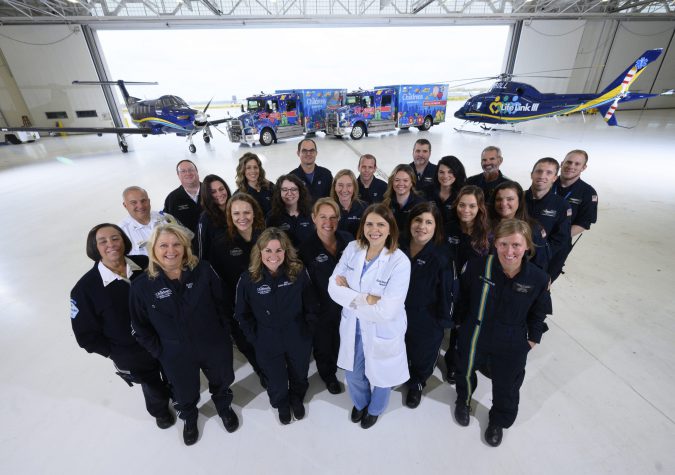For neonates, time is precious. Our neonatal transport team is able to transport newborns in need from any distance in the Upper Midwest. They receive specialized training to provide the safest transfer of patients, which can be done by ambulance, helicopter, fixed-wing plane or our critical care rigs. Transport service is available around the clock, seven days a week — the neonatal team is equipped to implement treatments such as nitric oxide and active cooling therapies immediately upon arrival at the hospital and during the transport.
“As medical director for the Children’s Minnesota neonatal transport team, I am extremely proud of the care our highly skilled team provides. Each year our team partners with referring hospitals around the Upper Midwest to transport hundreds of neonates to our Children’s Minnesota NICUs,” said Heidi Kamrath, DO, neonatal transport medical director and neonatologist. “We know that while most babies are born healthy, emergencies happen. Our neonatologists are accessible 24/7 by phone and virtual care where available for consultation. When transport is needed, our team is dedicated to providing high quality compassionate care to the families we serve.”
Meet two valuable members of the Children’s Minnesota neonatal transport team: Andy Rowe, RRT and Alison Olson, APRN, CNP. Andy is a respiratory therapist and critical care transport coordinator, and Alison is a neonatal nurse practitioner and transport team lead.

Read on as they provide information about their role and the highly complex, important program that they help lead to improve outcomes for newborns.
Q. What’s your background and what do you do on the team?
Andy: My training is in respiratory therapy and I’ve been with Children’s Minnesota for 11 years. For the past 5 years, I’ve been on the neonatal transport team and have managed the day to day operations since 2018. I love working on this well bonded team as we go into outlying communities with the opportunity to make a difference for neonatal patients, families and our referral hospitals.
Alison: I have worked in NICU for the past 10 years and have been a Neonatal Nurse Practitioner at Children’s Minnesota since 2017. I now serve as the NNP transport lead to guide policy and practice for the team as well as the care of neonatal patients requiring transfer from a community hospital to Children’s Minnesota when they require a higher level of care. My work helps assure quality and best outcomes for all newborns that come to the NICU at Children’s Minnesota.
Q. Can you tell me about the capabilities you carry with you when you transport a newborn?
Andy: We are prepared with all the capabilities of our Level IV NICU including high frequency ventilation, nitric oxide and active body cooling. Many preterm infants transported need high frequency ventilation (HFV). HFV can be very beneficial in reducing the risk for chronic lung disease for these fragile infants, by providing them with protective lung ventilation. For infants with respiratory failure such as severe hypoxia, respiratory distress syndrome, ELBW babies (23-26 weeks), persistent pulmonary hypertension of the newborn (PPHN), pneumothorax, meconium aspiration syndrome, we also carry inhaled nitric oxide (INO) on our transport incubators. The benefits of INO is that when inhaled, it relaxes and dilates the pulmonary vasculature allowing for improved oxygenation.
The sooner we can institute these techniques, the better the outcomes because it can prevent long term lung damage. Our goal is “out the door in 30 minutes of a call” and helps assure these care interventions can be applied as soon as possible!
Q. In addition to advanced respiratory care capability, you mentioned that you have “active” body cooling available on transport. For babies that have suffered hypoxic ischemic encephalopathy, is there criteria for when you may choose “passive” versus “active” body cooling?
Alison: When babies experience a hypoxic event or require resuscitation at delivery, community hospitals may start “passive” body cooling before we arrive. They may also be on the phone with Children’s Minnesota Physician Access or Neonatal Virtual Care for consult and continuing care guidance prior to our team arriving. Once we arrive, our transport team determines whether to use passive or active body cooling during transport.
Some of the decision making is based on proximity of the referring hospital because it takes some time to get the cooling machine set up and ready for cooling. If it is appropriate to initiate active body cooling, we use the Tecotherm Neo which is a blanket that is made up of tubes of water. The machine uses a thermometer to monitor the baby’s temp and sends that information to the blanket, adjusting the water temp as needed. It allows us to consistently cool the baby at a temperature of 33-34 degree Celsius quickly and safely. The treatment is continued once we reach Children’s Minnesota for 72 hours at which time we slowly bring their temperature back to normal as the treatment is completed. Total body cooling helps reduce secondary injury of the hypoxic insult and quick initiation is critical for best outcomes.